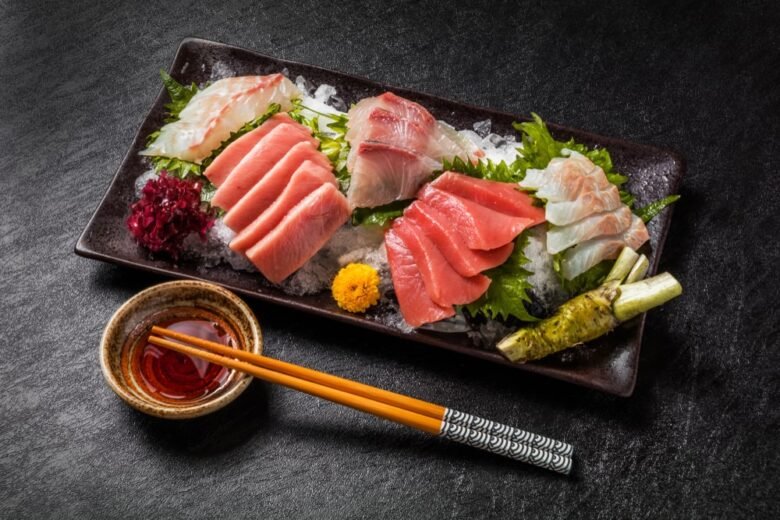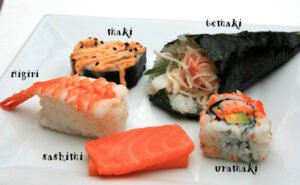Introduction to sushi and nigiri

Sushi and nigiri often grace the menus of Japanese restaurants, but do you know what’s really behind these delightful dishes? While many people use the terms interchangeably, they represent distinct culinary experiences. Whether you’re a sushi aficionado or just curious about your dinner options, understanding the differences between sushi and nigiri enriches your dining experience. Get ready to dive deep into their origins, ingredients, preparation methods, and more as we explore the fascinating world of these beloved Japanese delights. Your taste buds are in for an adventure!
Origins and history of sushi and nigiri
Sushi has its roots in Southeast Asia, dating back to the 2nd century. Originally, fish was preserved using fermented rice. This method helped extend its shelf life and reduce spoilage.
As time progressed, sushi made its way to Japan, evolving into various forms. By the Edo period (1603-1868), a more recognizable version emerged—nigiri sushi. It combined vinegared rice with fresh fish or seafood served atop.
Nigiri’s creation is attributed to street vendors who sought quick meals for busy city dwellers in Tokyo (formerly Edo). This innovation transformed sushi from a preservation technique into fast food.
The rise of nigiri coincided with the availability of fresh ingredients due to improved transportation methods. As people began to appreciate this new style, it became synonymous with Japanese cuisine worldwide. Each bite not only reflects a culinary tradition but also tells stories of cultural evolution through centuries.
Ingredients used in sushi and nigiri
Sushi and nigiri both share a foundation of key ingredients, but they also have their distinct elements. At the core of sushi is vinegared rice, known as shari. This rice is sticky and seasoned with a blend of vinegar, sugar, and salt to achieve that signature flavor.
Nigiri specifically features slices of raw or cooked fish placed atop small mounds of this seasoned rice. Common choices include salmon, tuna, and shrimp. Freshness is essential in both preparations.
In contrast, sushi can encompass various combinations including rolls (maki), which might incorporate additional ingredients like avocado, cucumber, or crab meat for added texture and taste.
Nori sheets are often wrapped around maki rolls but aren’t typically found in nigiri. The interplay between these ingredients creates unique dining experiences at every bite.
Preparation methods for sushi and nigiri
The preparation of sushi and nigiri involves distinct techniques that highlight their unique characteristics. Sushi often starts with vinegared rice, which is a blend of short-grain rice, sugar, vinegar, and salt. The rice must be cooked to perfection—sticky yet firm.
For rolls or maki sushi, the rolled assembly includes various fillings like vegetables or seafood wrapped in seaweed sheets called nori. A bamboo mat helps achieve tight rolls for presentation.
Nigiri takes a different approach. Here, hand-formed mounds of sushi rice serve as the base for slices of fresh fish or seafood placed on top. This method showcases both the texture and flavor of the ingredients.
Both require skillful handling to maintain freshness and quality. Precision is key; even minor adjustments can elevate each dish’s taste profile significantly.
Presentation and serving styles of sushi and nigiri
Presentation plays a crucial role in the enjoyment of sushi and nigiri. Each dish is often an art form, designed to please both the eye and palate.
Sushi rolls are typically displayed on elegant platters, garnished with colorful vegetables or delicate herbs. The careful arrangement enhances their vibrant colors, making them visually appealing.
Nigiri takes a more minimalist approach. A simple mound of vinegared rice topped with a slice of fish showcases the freshness of ingredients. Often served on wooden boards, it emphasizes simplicity and craftsmanship.
Diners usually receive soy sauce for dipping alongside wasabi and pickled ginger as palate cleansers. This trio elevates each bite, providing additional flavors that complement the main ingredient beautifully.
The overall experience is enhanced by traditional elements such as chopsticks or even hands for nigiri—creating a connection between food and culture that’s hard to replicate elsewhere.
Flavor profiles and variations of sushi and nigiri
Sushi and nigiri offer a delightful range of flavors that captivate the palate. Sushi typically combines vinegared rice with various toppings, creating an explosion of tastes. The freshness of fish plays a vital role, from buttery salmon to briny tuna. Vegetables like avocado or cucumber add crunch while pickled ginger provides a tangy contrast.
Nigiri, on the other hand, showcases simplicity and elegance. A small mound of sushi rice topped with fresh seafood highlights each ingredient’s quality. Often served with wasabi or soy sauce, it elevates the taste experience further.
Variations abound in both dishes. You’ll find temaki rolls bursting with flavor wrapped in seaweed as well as specialty nigiri featuring unique toppings like seared scallops or spicy mayonnaise drizzles. Each bite can transport you to different regions of Japan, reflecting local ingredients and traditions beautifully through its diverse offerings.
Nutritional value comparison between sushi and nigiri
When comparing the nutritional value of sushi and nigiri, it’s essential to consider their components. Sushi often includes rice, vegetables, fish, or other proteins wrapped in seaweed. The variety can lead to different calorie counts depending on the fillings used.
Nigiri consists mainly of a slice of fish atop a small mound of seasoned rice. This simplicity makes it lower in calories than some elaborate sushi rolls laden with sauces and toppings.
In terms of protein content, both offer beneficial nutrients from seafood. However, nigiri tends to have higher-quality fish portions due to its minimalistic approach.
Sushi may include more carbohydrates because of additional ingredients like avocado or tempura. Depending on preferences and dietary needs, one may opt for either option while keeping an eye on portion sizes for balanced nutrition.
Cultural significance of sushi and nigiri
Sushi and nigiri hold a special place in Japanese culture. They are more than just food; they embody tradition, artistry, and community.
Sushi has roots that trace back to ancient preservation methods. It was originally created as a way to ferment fish with rice. Over time, this practice evolved into the sushi we enjoy today.
Nigiri, on the other hand, showcases simplicity and craftsmanship. Each piece is often handcrafted by skilled chefs who focus on balance between flavors and textures.
These dishes are not merely meals but experiences shared among family and friends. Sushi bars serve as gathering spots where stories unfold over plates of beautifully arranged delicacies.
In Japan, there’s etiquette involved in enjoying sushi or nigiri—how you eat it can reflect respect for the chef’s artistry. This cultural significance elevates these dishes beyond mere sustenance to symbols of heritage and appreciation for culinary skill.
Common misconceptions about sushi and nigiri
Many people confuse sushi with nigiri, thinking they are the same. While nigiri is a type of sushi, not all sushi qualifies as nigiri. Sushi encompasses various forms including maki rolls and sashimi.
Another misconception revolves around the fish used in sushi. Many believe it always has to be raw. However, there are plenty of cooked options like shrimp tempura or unagi (grilled eel) that offer different textures and flavors.
Additionally, some think that sushi is only about seafood. In reality, vegetables can play a starring role too! Ingredients like cucumber and avocado bring freshness to many dishes.
There’s often confusion about soy sauce usage. People frequently drench their pieces in it when just a light dip suffices for optimal taste without overpowering the delicate flavors of fresh ingredients. Understanding these nuances enhances appreciation for this intricate cuisine.
Final thoughts on
When exploring the world of sushi and nigiri, it’s clear that these two culinary delights offer unique experiences. Sushi encompasses a broader category, showcasing various styles and forms that highlight the art of combining rice with different ingredients. On the other hand, nigiri stands out for its simplicity and elegance—just a slice of fish atop a compact mound of seasoned rice.
Understanding their origins enriches our appreciation. Both dishes have deep cultural roots in Japan, evolving over centuries to reflect local tastes and available ingredients. The choice between sushi and nigiri often comes down to personal preference—whether you enjoy the vibrant variety found in rolls or favor the straightforward charm of nigiri.
Ingredients play a vital role in this distinction as well. Sushi can include vegetables, seafood, or even tropical fruits wrapped within seaweed or rolled up tight with vinegared rice. Nigiri typically showcases quality fish sourced fresh from oceans around the world.
Preparation methods further set them apart; while both require skillful hands, making sushi involves intricate techniques like rolling or shaping while nigiri focuses on molding rice by hand before gently adding slices of fish.
Presentation matters too; sushi is often colorful and visually complex, designed to be shared among friends at gatherings. In contrast, nigiri offers an intimate experience where each piece highlights individual flavors without distractions.
The flavor profiles differ significantly as well—with sushi providing diverse combinations due to its range of fillings versus nagari’s focus on highlighting specific types of fish along with subtle hints from wasabi or soy sauce.
Nutritionally speaking, both options can vary depending on their composition but generally provide wholesome benefits thanks to fresh ingredients rich in omega-3 fatty acids when prepared correctly.
Culturally significant across many societies beyond Japan’s shores now too—sushi has gained worldwide popularity while maintaining its traditional roots through authenticity appreciated by purists everywhere!
Common misconceptions abound regarding these dishes: not all sushi contains raw fish; many assume all sushi must come rolled—but there’s so much more!



